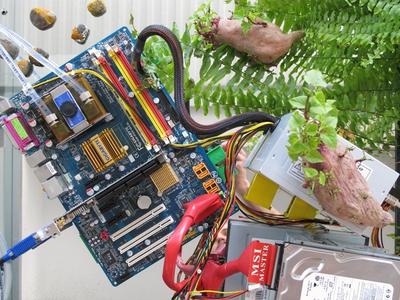Biomodd is a collaborative community-engaged art project that creates new relationships between nature and technology across different cultures around the world. In Biomodd, nature and technology are fused into hybrid interactive art installations. The core idea is the co-creation of experimental systems in which recycled computers and living ecosystems coexist and mutually reinforce one another. The recycled computers are connected into a network that runs a custom computer game. In this game, visitors, plants and other organisms interact in endlessly varying ways. Biomodd is an ongoing series of temporary experiments. It is always being developed on site with local communities, and aims to ignite critical conversations about our ideas on ecology, progress and our technological future.
E-waste is a primary resource for the project. Discarded computers are collected, and the participants learn to dismantle them. Subsequently, functioning computers are built out of the salvaged electronic components. These reconstituted computers are assembled into a local network, connected to the Internet. The heat that is generated by the computers is then used to to boost the growth of plants and other organisms within the physical network. Algae and aquaponics are used to liquid cool computer processors so they can be overclocked and run faster. In later versions of the project, sensors and robotics allowed for even more elaborate interactions between computers and biology.
Once completed, the hybrid network is used to run a customized multiplayer computer game. The Biomodd games thematically tie in with the overarching concepts of the project. They are either based on existing open source games, or are developed from the ground up by local team members. As more exhibition visitors join the virtual game, electronic components heat up, boosting the growth of surrounding plants, including algae. Such radical interdependencies are in fact echoed throughout the entire realization of the project: in the community of artists, scientists and designers who build Biomodd; among the visitors who directly participate in the game; and in the physical components of the installation (including the dependency between hot microprocessors and living chloroplasts).
Biomodd results in living immersive art installations. It opens a science fictional world in which biology and technology merge into idiosyncratic, fully operational hybrid systems. Through the grass-roots approach and the collaboration of culturally diverse teams, Biomodd translates the artistry, imagination and vision of a larger community. In this way, the installation does not only propose a visual artistic experience, but also a vision of a co-created future.
![Biomodd [NPL<sup>w</sup>]](https://cdn.sanity.io/images/t39t9igo/production/86e19e9408c2c22c51d085aee4d6841d8e158640-810x1080.jpg?w=1152)


